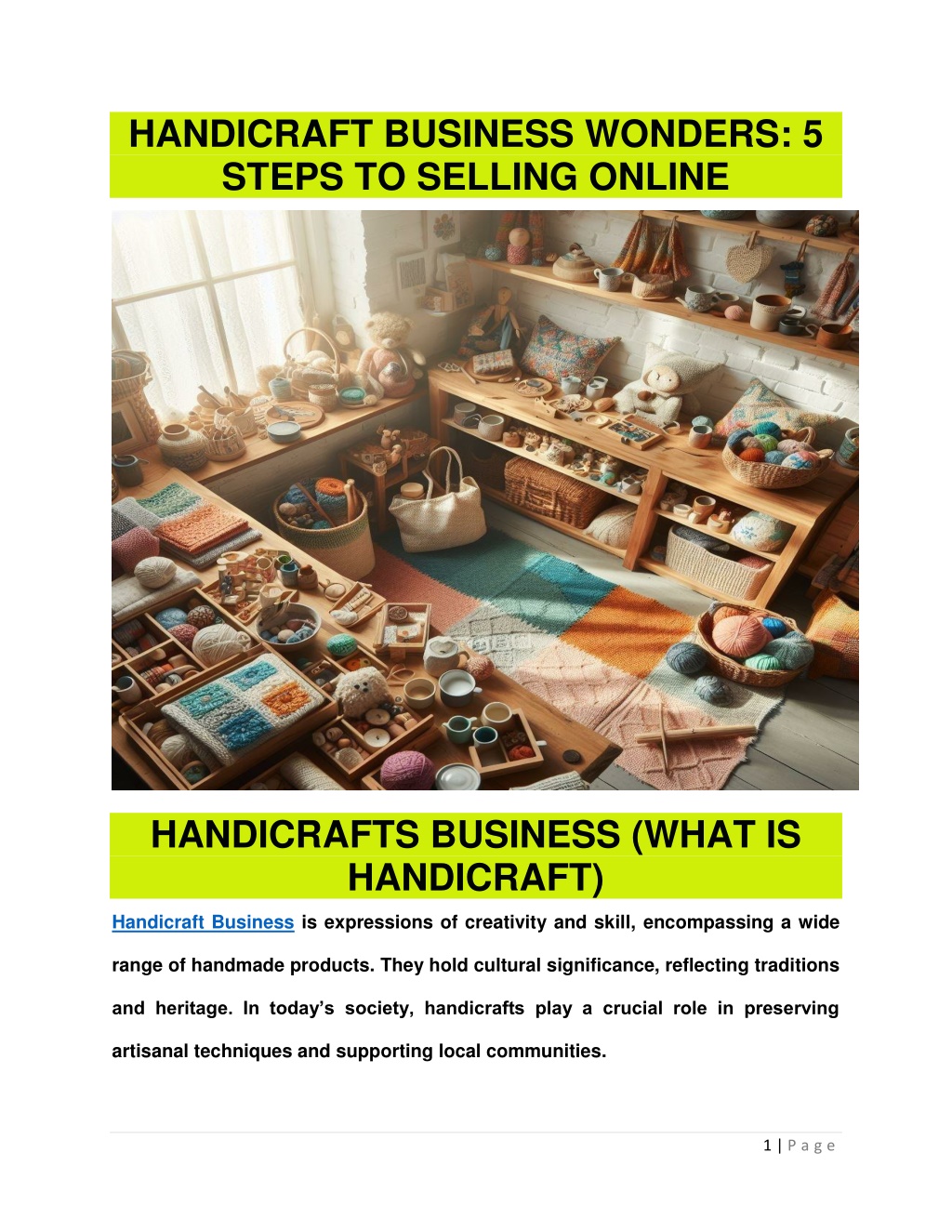
HANDICRAFTS BUSINESS (WHAT IS HANDICRAFT)
//seribangash.com/nThe Handicraft Business is expression of creativity and skill, encompassing a wide range of handmade products. They hold cultural significance, reflecting traditions and heritage. In todayu2019s society, handicrafts play a cru
Download Presentation

Please find below an Image/Link to download the presentation.
The content on the website is provided AS IS for your information and personal use only. It may not be sold, licensed, or shared on other websites without obtaining consent from the author. Download presentation by click this link. If you encounter any issues during the download, it is possible that the publisher has removed the file from their server.
E N D
Presentation Transcript
HANDICRAFT BUSINESS WONDERS: 5 STEPS TO SELLING ONLINE HANDICRAFTS BUSINESS (WHAT IS HANDICRAFT) Handicraft Business is expressions of creativity and skill, encompassing a wide range of handmade products. They hold cultural significance, reflecting traditions and heritage. In today s society, handicrafts play a crucial role in preserving artisanal techniques and supporting local communities. 1 | P a g e
Handicraft Business have been crucial to the cultural identity of societies worldwide, mirroring local customs, beliefs, and aesthetics. These artisanal traditions carry stories of craftsmanship, resilience, and heritage which have been passed down through generations. HISTORY OF HANDICRAFTS BUSINESS The history of the handicraft business traces back to ancient civilizations, where artisans crafted goods for practical and aesthetic purposes. However, it gained significant popularity during the Middle Ages in Europe, particularly in countries like Italy and France. The idea of formalizing handicraft production into a business model emerged as guilds formed to regulate and protect the interests of artisans. One of the earliest examples of a country adopting handicrafts as a formal business is Italy, where guilds known as artes or arti were established in cities like Florence, Venice, and Milan during the late Middle Ages. These guilds played a crucial role in organizing and promoting various crafts, ensuring quality standards, and facilitating trade. The concept of handicrafts as a business was not introduced by a single individual but evolved organically as societies recognized the economic potential of skilled craftsmanship. Guilds and merchant associations played key roles in shaping the handicrafts industry, laying the foundation for the commercialization and globalization of handicrafts in later centuries 2 | P a g e
TYPES OF HANDICRAFT BUSINESS TEXTILE HANDICRAFTS: Weaving: This process includes creating fabric by interlacing threads on a loom. Embroidery: Decorating of fabric with the needle and thread, mostly with intricate patterns and designs. Knitting and crocheting: This involves crafting fabric by interlocking loops of yarn with hooks or needles. People around the world make beautiful sweaters and bedspreads. Quilting: People use layers of fabric stitched together to create patterns or designs to make quilts. 3 | P a g e
POTTERY AND CERAMICS: Clay modeling: Clay modeling is also known as sculpting or modeling in clay. It is the art of making three-dimensional forms using clay as the primary medium. It s a flexible and approachable medium that allows artists to demonstrate their creativity and bring their ideas to life in a tactile form. Pottery wheel techniques: Potters use some fundamental skills to create different forms and shapes on a spinning wheel through pottery wheel techniques. However, designing functional vessels like bowls and cups or sculptures, and mastering pottery wheel techniques requires practice, patience, and a deep understanding of the medium. Glazing and firing: In the pottery-making process glazing and firing are the critical stages that allow artists to boost the beauty and resilience of their ceramic creations. Through experimentation with different glazes and firing techniques, potters can achieve a diverse range of textures, colors, and surface effects in their finished pottery. 4 | P a g e
PAPER CRAFT: Origami: Origami is the traditional Japanese art of paper folding in which artists make intricate shapes and figures by folding a single sheet of paper by cutting and gluing them. This originated in Japan several centuries ago, origami has evolved into a globally popular art form practiced by people of all ages and cultures. Paper quilling: Paper quilling which is also known as paper filigree is a decorative form of art that involves rolling, shaping, and arranging strips of paper to create delicate designs and patterns. This originated in Europe during the Renaissance period, quilling has developed over the centuries into a popular craft enjoyed by people of all ages around the world. 5 | P a g e
Handmade cards: In this time of digital diversity, handmade cards are creating quite a buzz. Personalized handmade cards for different occasions are becoming a new trend. You can make beautiful cards by using different techniques which include origami, paper quilling, collage, calligraphy, water paints, and media mix. TOOLS & TECHNIQUES IN HANDICRAFT BUSINESS Essential handicraft tools: When it comes to handicrafts, having the right tools can make all the difference in your projects. Here are some essential tools you might need: Cutting Tools: Scissors, craft knives, rotary cutters, and cutting mats are essential for cutting paper, fabric, and other materials with precision. Adhesives: Glue sticks, liquid glue, double-sided tape, and glue dots are necessary for assembling your projects and securing embellishments. 6 | P a g e
Rulers and Measuring Tools: A ruler, measuring tape, and T-square are handy for measuring and ensuring accuracy in your projects. Pens, Pencils, and Markers: These are essential for sketching designs, outlining shapes, and adding details to your projects. Paintbrushes and Paints: A variety of paintbrushes and paints, including acrylic, watercolor, and oil paints, allow you to add color and texture to your creations. Embellishments: Buttons, beads, sequins, ribbons, and other embellishments add detail and visual interest to your projects. Embroidery Supplies: Embroidery hoops, needles, embroidery floss, and fabric are necessary for hand embroidery projects. Stamping Supplies: Stamps, ink pads, and stamping blocks are essential for creating stamped designs on paper, fabric, and other surfaces. Paper Crafting Tools: Punches, scoring boards, bone folders, and corner rounders are useful for paper crafting and scrapbooking projects. Safety Gear: Protect yourself with gloves, goggles, and masks when working with potentially hazardous materials like adhesives, paints, and chemicals. Storage and Organization: Keep your tools and supplies organized with storage containers, bins, jars, and shelves to maximize efficiency and productivity. 7 | P a g e
Work Surface: A sturdy work surface like a table or desk with good lighting is essential for comfortably working on your projects. Pottery wheel: The pottery wheel is a fundamental tool used in ceramics to shape clay into various forms such as bowls, vases, and cups. It consists of a rotating disk powered by either a foot pedal or an electric motor. Some of the important components of a pottery wheel are a wheel head, motor, splash pan, bat system, adjustable speed, wheel size, stability and durability, and some basic accessories. Pottery wheels offer infinite possibilities for creating functional and decorative ceramic pieces, allowing artisans to explore their creativity and craftsmanship. Whether you re a beginner or an experienced potter, investing in a quality pottery wheel can upraise your ceramic artwork and provide countless hours of enjoyment. BASIC HANDICRAFT BUSINESS TECHNIQUES Handicraft business enclose a wide range of creative activities, each with its own set of techniques. Such as cutting and trimming, sewing, embroidery, knitting and 8 | P a g e
crocheting, weaving, quilting, paper crafting, decoupage, painting and drawing, pottery and ceramics, jewelry making, woodworking, These are just a few examples of basic handicraft techniques, but there are countless other methods and drills to explore. Whether you re a beginner or an experienced crafter, by mastering these basic techniques a world of creative possibilities can be opened up and helps to bring the artistic visions into life. ADVANCED CRAFTSMANSHIP SKILLS Block printing: Block printing is a traditional printing method where a design is carved into a block of wood, linoleum, or other materials. The carved block is then inked and pressed onto paper, fabric, or other surfaces to transfer the design. Block printing allows the creation of delicate and detailed designs, making it a popular choice for creating textiles, artwork, and decorative items. It s a versatile technique that can be adapted to various surfaces and styles, from traditional patterns to modern designs. Block printing is usually associated with artisanal craftsmanship and can add a unique and handmade touch to any project. Basket weaving: Basket weaving is a traditional craft that involves creating baskets by interlacing flexible materials such as reeds, vines, grass, or other natural fibers. Basket weaving is a flexible craft with a long history and cultural significance in many regions around the world. From functional storage baskets to sophisticated decorative pieces, the art of basket weaving offers endless possibilities for 9 | P a g e
creativity. Whether youre a beginner or an experienced weaver, experimenting with different materials and techniques can lead to beautiful and unique creations. Metalsmithing: The craft of shaping and maneuvering metal into various forms and objects through different techniques such as forging, casting, soldering, and fabrication is called metal smiting. MARKETING AND SELLING HANDICRAFTS Marketing and selling in handicraft business can be both rewarding and challenging. Here are some strategies to intelligently market and sell your handicrafts: PAPER CRAFT: Identify Your Target Audience: Understand who your potential customers are and what they value. Consider factors such as demographics, interests, and purchasing behavior to tailor your marketing efforts accordingly. Create a Unique Selling Proposition (USP): Highlight what sets your handicrafts apart from others in the market. Whether it s the quality, craftsmanship, design, or story behind your creations, focus on what makes them unique and appealing to customers. Establish an Online Presence: Set up a website or online store to showcase your handicrafts and reach a broader audience. Utilize social media platforms, such as 10 | P a g e
Instagram, Facebook, Pinterest, and Etsy, to promote your products, engage with customers, and drive sales. Professional Product Photography: Invest in high-quality images that accurately represent your handicrafts and highlight their features. Clear, luminous photos from multiple angles can attract attention and increase the possibility of sales. Tell Your Story: Share the inspiration, process, and craftsmanship behind your handicrafts to create a connection with customers. Personal stories and behind- the-scenes glimpses can add value and authenticity to your brand. Offer Customization and Personalization: Provide options for custom orders or personalized touches to cater to individual preferences and special occasions. This can enhance the perceived value of your handicrafts and attract customers seeking unique and bespoke items. Participate in Craft Fairs and Markets: Showcase your handicrafts at local craft fairs, markets, and artisanal events to connect with customers face-to-face, receive feedback, and build relationships within the community. Collaborate with Influencers and Bloggers: Partner with influencers, bloggers, or local artisans who align with your brand and target audience to reach new customers and gain exposure through their networks. Offer Exceptional Customer Service: Provide excellent customer service by promptly addressing inquiries, processing orders efficiently, and ensuring a 11 | P a g e
positive buying experience. Satisfied customers are more likely to return and recommend your handicrafts to others. Collect and Showcase Customer Reviews: Encourage satisfied customers to leave reviews and testimonials about their experience with your handicrafts. Positive reviews can build trust and credibility, helping to attract new customers. By implementing these strategies and consistently refining your approach based on feedback and market trends, you can effectively market and sell your handicrafts and grow your business over time. Remember to stay passionate, creative, and adaptable as you navigate the world of handmade goods. COUNTRIES WELL KNOWN FOR HANDICRAFTS 1. India: India has a long history of handicraft business, with each region known for its unique styles and techniques. Indian handicrafts include textiles (such as silk weaving and embroidery), pottery, metalwork, woodwork, and jewelry. 2. China: China has a diverse range of handicraft traditions that have been practiced for centuries. Chinese handicraft business include ceramics, porcelain, silk embroidery, paper cutting, and traditional painting. 3. Mexico: Mexican handicrafts are famous for their vibrant colors and intricate designs. Traditional crafts in Mexico include pottery (such as Talavera), textiles (like woven rugs and embroidered garments), metalwork, and folk art. 12 | P a g e
4. Morocco: Morocco is renowned for its rich artisanal heritage, influenced by Berber, Arab, and Andalusian cultures. Moroccan handicraft business include leatherwork, ceramics (such as colorful zellie tiles), textiles (including intricate carpets and embroidered fabrics), and metalwork. 5. Italy: Italy is known for its craftsmanship and artistic tradition, which is reflected in its diverse range of handicrafts. Italian handicrafts include glassware (such as Murano glass), ceramics (like Tuscan pottery), leather goods, and artisanal textiles (such as silk scarves and lace). 6. Indonesia: Indonesia is home to a wide variety of handicraft traditions, influenced by its diverse cultural heritage. Indonesian handicrafts include batik textiles, wood carvings (such as Balinese masks), metalwork, and traditional weaving (like ikat and songket). 7. Thailand: Thailand is known for its intricate craftsmanship and attention to detail in its traditional handicrafts. Thai handicrafts include ceramics, silk weaving, wood carving (such as teak sculptures), and traditional Thai painting. 8. Turkey: Turkey has a rich tradition of handicrafts that blends influences from the Ottoman, Byzantine, and Persian empires. Turkish handicraft business include ceramics (such as Iznik pottery), textiles (like Turkish carpets and kilims), metalwork (including copper and brass), and traditional Turkish marbling (Ebru). 13 | P a g e
ONLINE PLATFORMS There are numerous online platforms where you can sell your handicrafts and reach a wide audience. Here are some popular options: Etsy: Etsy is one of the largest online marketplaces for handmade, vintage, and unique goods. It s known for its supportive community of artisans and customizable storefronts. Amazon Handmade: Amazon Handmade is a marketplace within Amazon dedicated to handmade products. It offers a wide reach and the convenience of Amazon s established infrastructure. eBay: eBay provides a platform for selling a variety of goods, including handmade items. It allows you to reach a global audience and offers various listing options, including auctions and fixed-price listings. Shopify: Shopify is an e-commerce platform that allows you to set up your own online store. It provides customizable templates, payment processing, and marketing tools to help you create a professional-looking storefront. Big Cartel: Big Cartel is a platform specifically designed for artists and makers. It offers customizable storefronts, simple pricing plans, and features tailored to the needs of small businesses and independent creators. 14 | P a g e
Instagram: Instagram is a powerful platform for showcasing visual content, making it ideal for promoting handicrafts. You can use Instagram to showcase your products, engage with customers, and drive sales through direct messages or by linking to your online store. Facebook Marketplace: Facebook Marketplace allows you to list and sell your handicrafts directly to local buyers. It s a convenient option for reaching customers in your area and facilitating in-person transactions. Pinterest: Pinterest is a visual discovery platform where users can discover and save ideas for various projects and products. You can use Pinterest to showcase your handicrafts, drive traffic to your online store, and reach users searching for inspiration. Artfire: Artfire is an online marketplace specifically for handmade, vintage, and artisanal goods. It offers customizable storefronts, marketing tools, and a supportive community of sellers. Local Craft Websites: Explore local or regional online marketplaces and directories dedicated to showcasing handmade and artisanal products. These platforms may offer opportunities to connect with local customers and participate in community events. 15 | P a g e
COLLABORATION AND COMMISSIONS: Collaborations and commissions are fantastic opportunities to expand your reach and creativity in the world of handicrafts. Here s how you can leverage these avenues: Collaborations: Partnering with other artists, designers, or businesses can lead to exciting projects and mutual benefits. Look for collaborators whose style and values align with yours, and explore opportunities for joint product launches, events, or marketing campaigns. Collaborations can help you reach new audiences, gain exposure through cross-promotion, and tap into new creative ideas and perspectives. Commissions: Accepting commissions allows you to create customized pieces tailored to individual customers preferences and needs. Whether it s a personalized gift, bespoke artwork, or custom-designed jewelry, commissions 16 | P a g e
offer a unique opportunity to connect with customers on a personal level and create one-of-a-kind pieces that hold special meaning. Be sure to communicate clearly with clients about their vision, timeline, and budget, and provide updates and previews throughout the creative process to ensure their satisfaction. PRESERVING AND PROMOTING HANDICRAFTS: Preserving and promoting handicrafts is essential for preserving cultural heritage, supporting artisan communities, and fostering sustainable economic development. Here are some strategies for achieving these goals: Documentation and Research: Start by documenting and researching traditional handicraft techniques, materials, and cultural significance. This information serves as a valuable resource for preserving and transmitting traditional knowledge to future generations. Skill Development and Training: Provide training programs and workshops to artisans to enhance their skills, learn new techniques, and adapt to changing market demands. This empowers artisans to improve the quality of their products and innovate while staying true to traditional craftsmanship. Market Access and Fair Trade Practices: provide market access for artisans by connecting them with local and global markets through fair trade practices, artisan cooperatives, and online platforms. Promote fair wages, transparent pricing, and 17 | P a g e
ethical production practices to ensure that artisans receive fair compensation for their work. Cultural Exchange and Collaboration: Encourage cultural exchange and collaboration between artisans from different regions and cultures. This fosters creativity, cross-cultural understanding, and the exchange of ideas, techniques, and designs. Education and Awareness: Raise awareness about the importance of handicrafts in preserving cultural heritage and supporting sustainable livelihoods. Educate consumers about the value of handmade products, the stories behind them, and the impact of their purchasing choices on artisan communities. Policy Support and Advocacy: Advocate for policies that support the preservation and promotion of handicrafts, including incentives for artisan entrepreneurship, funding for craft education and training programs, and protection of intellectual property rights for traditional designs. Innovation and Adaptation: Encourage innovation and adaptation in handicrafts by combining traditional techniques with modern materials, technologies, and design trends. This allows artisans to create contemporary products that appeal to changing consumer preferences while preserving cultural authenticity. Tourism and Cultural Experiences: Promote handicrafts as part of cultural tourism experiences, showcasing artisan workshops, craft markets, and cultural festivals. 18 | P a g e
This provides opportunities for visitors to engage with artisans, learn about traditional crafts, and support local economies. Collaboration with Academia and Institutions: Collaborate with academic institutions, museums, and cultural organizations to research, document, and preserve handicraft traditions. This collaboration can also support educational initiatives, exhibitions, and cultural events that raise awareness about handicrafts. Community Engagement and Empowerment: Involve local communities in the preservation and promotion of handicrafts by supporting community-based initiatives, cooperatives, and social enterprises. Empower artisans to take ownership of their craft traditions and participate in decision-making processes that affect their livelihoods. By implementing these strategies, stakeholders can work together to preserve the rich heritage of handicrafts, support artisan communities, and promote sustainable economic development rooted in cultural diversity and creativity. CONCLUSION In conclusion, starting a handicraft business presents a fantastic opportunity for entrepreneurs seeking a profitable business in 2024. By adopting the right handicraft business model, you can create the most profitable handicraft business that resonates with consumers while remaining budget-friendly. This venture is among the best and cheap business options, being an easy and low investment business with the 19 | P a g e
potential for a cheap investment and high profit business. A detailed handicraft business plan is essential for outlining your vision and strategies, especially concerning handicraft business income. Developing appealing handicraft business cards and logo will enhance your branding. Additionally, understanding the handicraft business startup cost and acquiring the right handicraft business equipment will ensure a smooth launch. It s also vital to define your handicraft business description and meet the handicraft business requirements for compliance. Resources from the International Handicraft Business Association can offer valuable guidance, particularly for those interested in the handicraft business in India, UAE, or Pakistan. Exploring innovative handicraft business marketing ideas and leveraging handicraft business software can enhance operational efficiency. Lastly, brainstorming catchy handicraft business name ideas will help distinguish your brand in a competitive marketplace. With careful planning and creativity, your handicraft business can thrive and succeed in this vibrant industry. For more business blogs please : https://seribangash.com/ https://seribangash.com/barber-shop-business-complete-guide-for-beginners/ https://seribangash.com/computer-accessories-shop-8-innovative-ideas/ https://seribangash.com/pakistan-budgeting-process-basic-types-of-budget/ 20 | P a g e






















